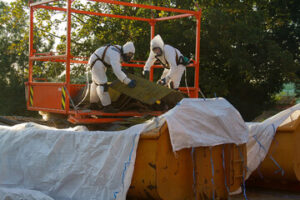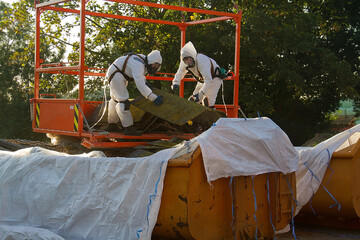Asbestos has unique properties that make it desirable in many manufactured products. These properties include fire resistance, heat, chemical and biological break-down resistance, and tensile strength.
However, tiny fibers can become airborne when asbestos materials are tampered with or removed unsafely. Once in the air, they can be breathed into the lungs and cause illness. Keep in mind that you must call Asbestos Perth experts to handle this.
 Asbestos is a group of naturally occurring fibrous minerals that are very strong, fire-resistant, and flexible. It has been used in over 3,000 commercial and industrial products for its heat resistance, strength, and insulating properties. Many older homes and commercial buildings contain asbestos in building materials such as asbestos cement shingles, insulation, and pipe wraps. It has also been used in paper products and felts such as fireproofing textiles; paints, coatings, and adhesives; and friction materials such as automotive clutch pads, brake linings, and shoes. It has also been found in vermiculite-containing garden products and some talc-based crayons.
Asbestos is a group of naturally occurring fibrous minerals that are very strong, fire-resistant, and flexible. It has been used in over 3,000 commercial and industrial products for its heat resistance, strength, and insulating properties. Many older homes and commercial buildings contain asbestos in building materials such as asbestos cement shingles, insulation, and pipe wraps. It has also been used in paper products and felts such as fireproofing textiles; paints, coatings, and adhesives; and friction materials such as automotive clutch pads, brake linings, and shoes. It has also been found in vermiculite-containing garden products and some talc-based crayons.
When the fibers are inhaled, they can stick to the lungs and irritate lung tissue. Over time, this can lead to serious health problems such as pleural effusion (fluid buildup between the chest wall and the lungs), fibrosis, lung cancer, and mesothelioma. These symptoms can develop long after exposure has stopped.
Although medical tests can detect asbestos fibers in urine, feces, or mucous, the only way to confirm that lung disease is caused by asbestos is by taking a biopsy of lung tissue and analyzing it under a microscope. This is why it’s important to seek out licensed professionals to handle any remodeling or cleaning jobs that may involve asbestos.
The potential for asbestos materials to release fibers into the air is based on whether they are friable or not. Any material that can be crumbled, pulverized, or reduced to a powder with hand pressure is considered friable and likely to release asbestos fibers into the air. Asbestos-containing roofing and siding shingles, asbestos-cement patching and joint compounds, and asbestos-containing paint are considered friable and could release fibers into the air if they are sawed, scraped, or sanded.
Asbestos enters the body in one of two ways: when it is inhaled or swallowed. Once asbestos fibers are inhaled, they can become trapped in the lungs and cause inflammation and scarring, which over time can lead to serious health problems including cancer.
Inhalation of asbestos fibers is the most common way that they can harm a person’s health. The microscopic fibers that makeup asbestos are easily inhaled and can remain in the lungs for many years. This can cause the development of a serious lung condition called mesothelioma and also a less severe but still very dangerous condition called asbestosis.
People can be exposed to asbestos by handling or breathing in loose asbestos particles when it is damaged, disturbed, or removed unsafely. This can happen when old asbestos products like insulation, roof tiles and shingles, fireproofing materials, paints and other coatings, and vermiculite attic insulation begin to break down or degrade.
If you ingest asbestos by accident (either those present in water or those moved to your throat from the lungs), nearly all of the asbestos fibers pass along the intestines within a few days and are excreted in feces. However, a small number of the fibers penetrate cells that line the stomach and intestines, and some of those become trapped in other tissues or are removed in urine.
Asbestos can also be ingested by eating certain kinds of seafood, such as clams, that are contaminated with asbestos. But because the harmful effects of asbestos only develop over decades, the most likely way that this will happen is by breathing in the fibers while working on remodeling a home or other building projects where asbestos might be located.
Asbestos exposure puts certain people at higher risk for asbestos-related diseases. The most common asbestos-related disease is mesothelioma. This rare and fatal lung cancer occurs when asbestos fibers reach the lining of the lungs (pleura). Asbestos exposure also increases a person’s risk of developing non-cancerous conditions like asbestosis, pleurisy, or diffuse pleural thickening.
These conditions involve scarring of the lungs that makes it difficult for the lungs to do their job of bringing oxygen into the body. Symptoms include shortness of breath, coughing, tightness in the chest, and a bluish color in the skin. In some cases, asbestos exposure can lead to cancer of the throat, esophagus, or stomach.
People who were exposed to asbestos in the workplace are at higher risk for an asbestos-related illness. This includes people who worked on ships and shipyards, those who mined or milled asbestos materials, and those who built with or repaired asbestos products. It is also possible to develop an asbestos-related disease without having workplace exposure. This is known as para-occupational exposure. It involves breathing in asbestos particles on clothing, shoes, and other items brought home from work.
Additionally, those who lived or worked on military bases in the past may have had exposure to asbestos through building materials and other products. Many homes built before the 1970s contain asbestos drywall, ceiling tiles, and insulation. Some asbestos was also used in automobile brakes and clutches, fireproof gloves, and curtains. Asbestos is also found in cement, vermiculite attic insulation, and some plastics. The most common type of asbestos is white, a fibrous material known as chrysotile. It is less toxic than blue, brown, and gray asbestos.
When asbestos fibers become airborne, they can be inhaled. This can lead to the development of lung diseases such as pleural effusions, asbestosis, and mesothelioma. Individuals can become exposed to asbestos through work in construction, shipbuilding, mining, manufacturing, and other industries. Workers may also be exposed to environmental exposure, such as living near a mine or working on a building constructed before 2000 that contains asbestos.
While asbestos is dangerous, most people who are exposed to it do not experience symptoms right away. This is because the body’s natural defenses remove most of these tiny fibers from the lungs, and the ones that remain bypass those defenses to lodge deep within the lung tissue. Many asbestos-related diseases develop decades after exposure, so it is important to seek regular checkups.
To find out if you have asbestos exposure, your doctor will ask about your occupational history and whether you have been in contact with materials that contain asbestos. Then, your doctor will listen to your lungs with a stethoscope and perform a pulmonary function test. This will determine how well your lungs are functioning and how much scarring they have from asbestos exposure.
There are six different types of asbestos, and each has unique properties. Amphibole asbestos fibers are straight and jagged and appear needle-like when they’re inhaled. They cause inflammation and scarring of the lung tissue. This condition is called asbestosis or interstitial fibrosis and is the most common form of lung disease caused by asbestos. Crocidolite asbestos, on the other hand, is softer and less resistant to heat. It is more likely to cause cancer and other diseases. This type of asbestos is found in asbestos cement, tiles, and insulation.
A person exposed to asbestos through work should tell their primary care physician (PCP) if they have any respiratory or other symptoms. Doing so creates a record that will make it easier for doctors to detect signs of an asbestos-related disease and monitor patients.
Keeping up with regular checkups can also help. It will help doctors notice early on if any of the symptoms begin to appear, such as coughing, difficulty breathing, or chest pain. Those with asbestos-related mesothelioma, for example, are more likely to develop lung cancer than those who do not have the disease, and they will need to be monitored closely.
If you are worried that asbestos is present in your home, you should hire a licensed asbestos professional to test the material. It is important to find a qualified asbestos specialist because disturbing the material could make the fibers airborne and therefore more dangerous.
Only professionals who have completed a federally approved asbestos course can perform asbestos removal. You should ask any asbestos professional for proof of their credentials before hiring them. State health departments and EPA regional offices can provide lists of licensed asbestos professionals in your area.
Asbestos products that are in good condition will not pose a threat to your health. However, you should inspect the material regularly and repair any damaged areas immediately to prevent the release of asbestos fibers into the air. Also, you should never smoke around asbestos materials because smoking increases the risk of developing an asbestos-related illness. If you do smoke, make sure to use an approved respirator whenever you are in the vicinity of any asbestos material. Lastly, you should avoid any renovation or demolition work on an old building that contains asbestos because this work will disturb the material and potentially release asbestos fibers into the air.
